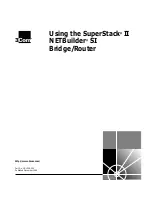
60
C
HAPTER
4: I
NSTALLING
D
YNAMIC
A
CCESS
S
OFTWARE
IN
W
INDOWS
Verifying Successful Installation
After the Dynamic
Access
software is installed on the server
PC, the following changes are visible in the Windows
Network control panel:
■
For each physical NIC installed in the client PC, a virtual
NIC entry appears in the list of network adapters.
All protocols are re-bound to the virtual NIC. The
bindings to the physical NIC are still intact.
■
A 3Com Dynamic
Access
entry appears as a protocol.
■
A 3Com Dynamic
Access
icon is installed in the
Windows Control Panel.
Configuring Groups and VLANs for a Server NIC
Dynamic
Access
technology server features allow you to
configure load balancing groups and virtual LANs (VLANs).
The features are described in Advanced Server Features on
page 17.
The following Dynamic
Access
technology server features
are available for NIC groups in Windows:
■
load balancing
■
RSL failover
■
multiple VLANs
The examples in this section illustrate typical actions you
might take in the course of maintaining a Dynamic
Access
server configuration in Windows.
Planning the Configuration
Consider these items when planning groups and VLANs:
■
Decide whether you want to use bidirectional load
balancing, or transmit load balancing.
To use bidirectional load balancing, you must assign a
dedicated IP address for each load balancing group. This
address must be unique (not used elsewhere on the
network). For details, see Specifying a Dedicated IP
Address on page 66.
■
Decide which NICs are to be part of each group. Each
group must include at least two NICs.
















































